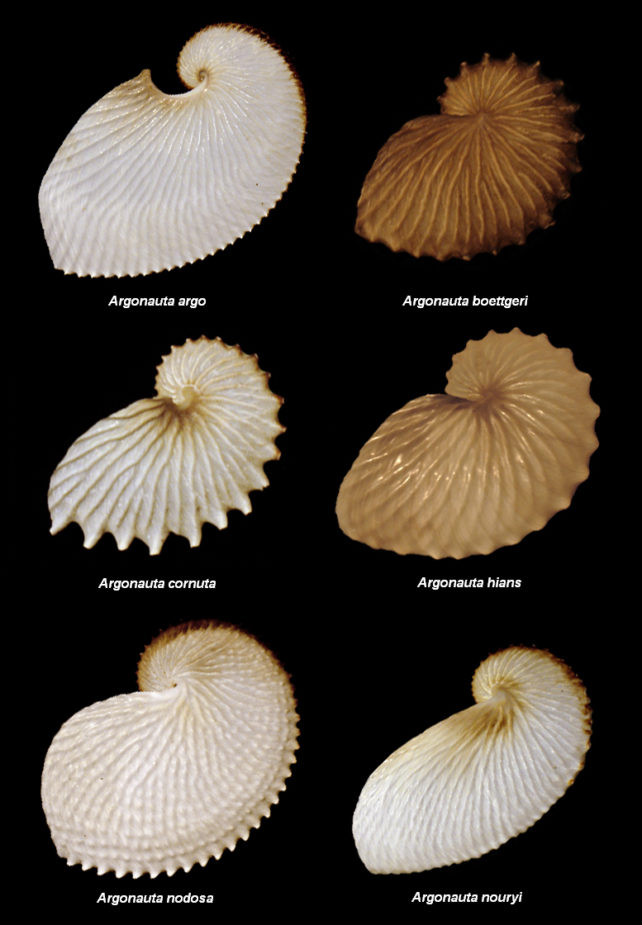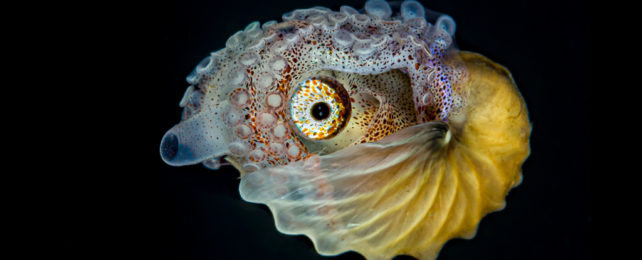Long after its ancestors deleted their genetic code for a tough coat of armor, a seafaring octopus has reinvented a recipe for making a shell.
A recent genetic analysis of the paper nautilus or greater argonaut (Argonauta argo) has revealed a surprising origin for its protective casing, one that doesn't resemble the shell of its closest relatives.
Instead of wearing their shells on the outside like sensible snails, most cephalopods (which are also mollusks), have done away with their tough outer garment. Many, like octopus and squid, have either lost their shells entirely or have only vestigial remnants left.
Others, like cuttlefish and the ram's horn squid (Spirula spirula), wear their shells on the inside. The ram's horn squid has an internal chambered spiral shell that acts like a skeleton of sorts. Buoyant and surprisingly durable, it's often found washed up on beaches.
A rare exception among cephalopods is the nautilus (Nautilus belauensis), which still has an external shell – complete with air chambers that it uses to regulate its buoyancy as it floats through the open oceans. Its shell, and those of the now-extinct cephalopod ancestors, comprise of proteins incorporating minerals such as aragonite and calcite in intricate microscopic structures.
Having originated sometime in the Ordovician period, at least 440 million years ago, ancestors of all modern cephalopods are thought to have had these protective structures.
In spite of being commonly referred to as paper nautili, argonauts are actually a genus of octopus. In this unusual group, only the females produce a protective spiral casing, by secreting calcifying proteins from their arms. Argonauts wear these shells externally like a nautilus does, and their shapes are almost identical, yet this shell has a completely different microscopic structure.
What's more, instead of being attached to their mantle, argonauts grip onto their shell homes with several of their arms.

As most octopuses lost their external casings long ago, researchers have wondered how and why a single group reclaimed a shell.
Working with a team of researchers from across Japan, marine biologist Masa-aki Yoshida from Shimane University sequenced the DNA of Argonauta argo. They compared the argonauts' genome to other mollusks, including the California two-spot octopus (Octopus bimaculoides) and the nautilus.
"Consistent with previous results, most of the proteins are apparently not shared with the shell matrix proteins of [cephalopods and relatives], including those of Nautilus," the team writes in their paper.
Some of the genes and the proteins they express have, however, been found in other shelled mollusks like the limpet (Lottia gigantea) and Japanese pearl oyster (Pinctada fucata). Other sequences were found in shell-less octopuses – suggesting the argonaut cobbled together their protective casing using proteins unrelated to ancestral shell formation.
Unlike other octopuses, argonauts aren't benthic – they don't live near the sea floor or other structures. Instead, they've taken on the life of drifters, floating amidst the tropical and subtropical open seas their entire life. This is the same pelagic lifestyle shared by the nautilus.
To achieve this, argonauts needed techniques to allow easy floating too, Yoshida and team explain. While their shell lacks the nautilus' more complicated internal structure of air chambers, it can still trap some air.
This shell is also known to be the argonaut's egg case, which would explain why only females develop them. The females brood their eggs within the shell's protection, eliminating the need to hide their eggs away on a substrate like the sea floor as most other octopus do.
Argonauts appear to have completely reinvented the shell from scratch to aid its transition from substrate dweller to water drifter, mimicking the nautilus in a remarkable example of convergent evolution.
This research was published in Genome Biology and Evolution.
